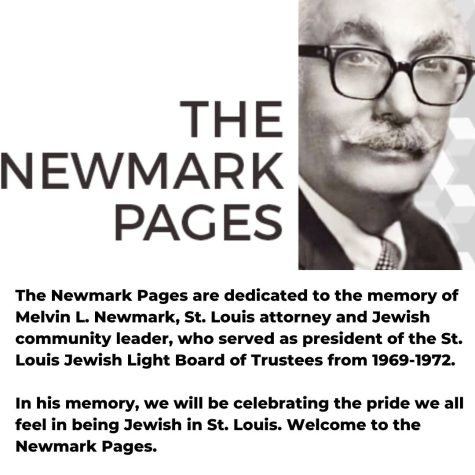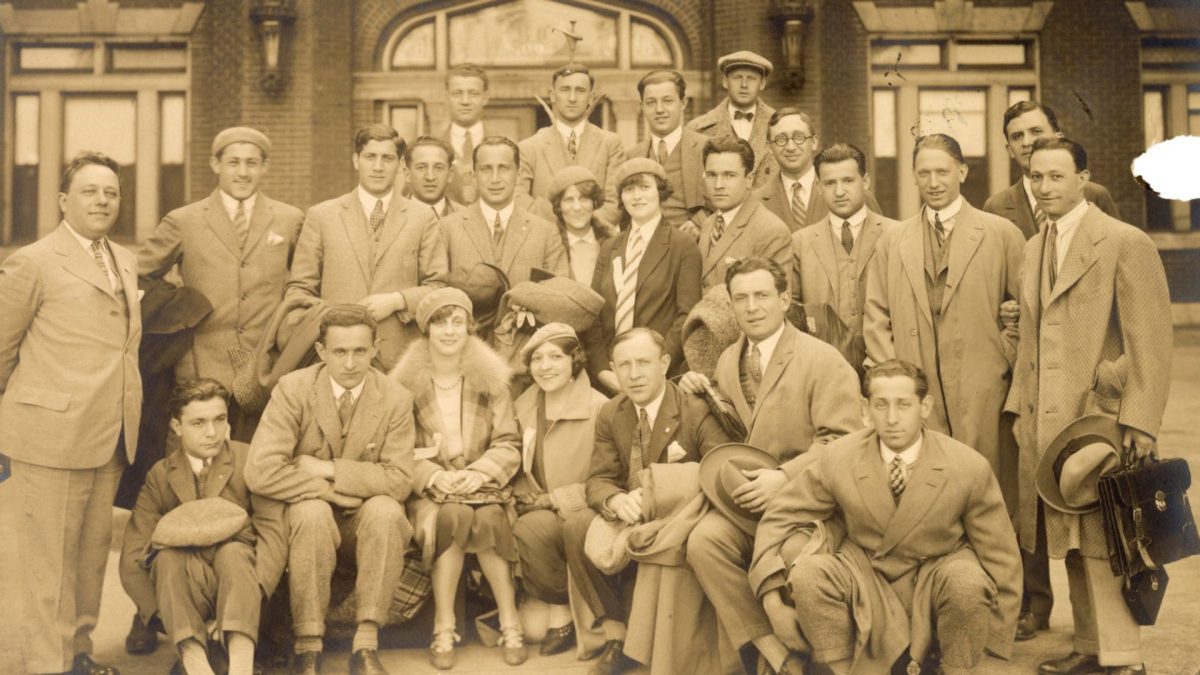How a 1926 soccer match divided the St. Louis Jewish community
The entire Hakoah Vienna Soccer team prior to their match with the St. Louis All-Stars, on May 15th, 1926. Courtesy of St. Louis Kaplan Feldman Holocaust Museum, Jewish Community Archives.
Published August 3, 2023
 On April 1, 1926, the Jewish Daily Bulletin, a precursor of the Jewish Telegraphic Agency (JTA) published the following information, and it was no joke.
On April 1, 1926, the Jewish Daily Bulletin, a precursor of the Jewish Telegraphic Agency (JTA) published the following information, and it was no joke.
“A game between the Hakoah Jewish soccer team of Vienna, and an all-star St. Louis soccer team has been arranged by representatives of both organizations.
“The contest will be played in May. St. Louis will be the farthest West that the internationally known Vienna soccer team will travel. Aaron Waldheim has been appointed Honorary chairman of the St. Louis Committee.”
At the time Waldheim, the then-president of the St. Louis Jewish Hospital Association, probably was excited about bringing this famed Austrian team to St. Louis, as current fans were when STL City opened their season downtown in the spring. But little did he know of the controversy awaiting him and the St. Louis Jewish community.
Hakoah Vienna: The beginning
Taking the name of the Hebrew word for strength, the “Hakoah Sports Club” was founded in 1909 and became the largest and best-known Jewish all-around sports club in pre-war Europe. The club emerged as an expression and representation of Jewish identity in Vienna and became a social hub for many Viennese Jews.
Soccer, which was surging in popularity, became a major focus for the club. The skilled Hakoah team quickly developed a reputation both on and off the field, as “tough, aggressive and smart Jewish boys.” Their reputation made them the darlings of the growing Zionist movement, and soon a worldwide tour was planned to showcase the team.
The club began touring in 1925 and found immediate success. In his 2004 book, “How Soccer Explains the World: An Unlikely Theory of Globalization” author Franklin Foer wrote, “Hakoah was exporting more than a successful sporting brand. Instead of selling jerseys, Hakoah sold Zionism. There was an appetite for both ideology and soccer in the mid-1920s.”
In 1926, as the Jewish Daily Bulletin reported, Hakoah Vienna announced a 10-game tour of the United States that would include a game in St. Louis. American Zionists saw the tour as an opportunity to bring an often-divided Jewish community together under its banner. High-profile Jewish leaders became involved in all aspects of the tour, including Louis Brandeis, Henry Morgenthau and Fredrick Warburg.
The Controversy
But despite the team’s growing popularity in America, not everyone was pleased with the Austrian visitors.
In his book “Jews and the Sporting Life: Studies in Contemporary Jewry XXIII,” Ezra Mendelsohn wrote: “Religious Jews expressed dismay that four of the team’s 11 matches were scheduled for Saturday afternoons. In their view whenever Hakoah played on the Sabbath, it was violating the cardinal rules both of its mission and faith.”
On April 26, 1926, just three days before the team was to open play in New York, a predominantly Orthodox group called the “Jewish Sabbath Alliance” began an effort to have the tour canceled. Rabbi Israel Rosenberg, the group’s executive secretary, told the New York Times, “We will leave no stone unturned since actions such as these tend to break down not only the religious but also the Jewish national spirit.”
The protests grew as more and more New York and national Jewish groups protested and boycotted the Hakoah.
With the Hakoah team’s game in St. Louis fast approaching, two local Orthodox rabbis wrote a personal protest letter that was published in St. Louis’ Yiddish language Jewish Record. Rabbis Israel Lebendiger and Abraham Halperin declared “that the prestige the Hakoah adds to the Jews, cannot be attained at the price of the desecration of the Sabbath. While it’s possible Hakoah will lift our national prestige among non-Jews, they will likely not serve as a spiritual reservoir for national existence.”
But the St. Louis rabbis did not go unchallenged. According to Mendelsohn, the Jewish Record’s popular columnist Y.I. Sivitz, a self-described “free thinker,” jumped to the defense of the Jewish soccer club.
“For Sivitz, the good these so-called “shktosim” (sinners) were doing for the Jewish people far outweighed their religious transgression,” wrote the author. “Writing somewhat hyperbolically, Sivitz reminded his readers that it was Hakoah members who defended religious Jews from Austrian antisemites and bullies.
“Hakoah is worth far more to the Jewish people than the hundreds of Jews who say psalms in synagogue and the hundreds of students who fill America’s Yeshivas,” wrote Sivitz. “Rabbis Lebendiger and Halperin would do better to focus their vitriol on members of their own synagogues who work on the Sabbath, drive to services in their ‘weekday’ automobiles, smoked and mocked G-d’s Sabbath.”
Sivitz ended his column by urging St. Louis Jews, and particularly the youth, to turn out to see Hakoah win over their non-Jewish colleagues. “Come, let us celebrate their victories, even if they happen to lose.”
Hakoah Vs. St. Louis
Despite the protests, St. Louis soccer fans filled St. Louis University Field to capacity, some 7,000 strong.
“The Hakoah soccer eleven from Vienna defeated a picked team of the St. Louis Soccer League Saturday afternoon,” wrote the New York Times on May 16, 1926. “The visitor played a machine-like short passing game, which was featured by many novel movements.”
Hakoah would go on to win six of its 10 tour matches and draw an estimated 200,000 fans to watch them play. A week after the Shabbat Saturday match in St. Louis, Jewish Record columnist Nat S. Hurwitz, got the final say on the matter.
According to Mendelsohn, in his “Sense and Nonsense” column, Hurwtiz wrote a tongue-in-cheek piece stating, “With the ‘Shabbas Goyim’ gone, the atmosphere has returned to its normal kosher self. All is well again. Nothing to complain about, no one to blame and not even a heard. G-d bless the righteous. Amen.”
Game noted in St. Louis exhibit
St. Louis’ love for soccer can be traced back to 1875 according to the current exhibit “Soccer City” at the Missouri History Museum.
The exhibit traces St. Louis’ soccer history from the first recorded soccer-like game at the future site of Sportsman’s Park to the city being awarded a Major League Soccer team, the first majority female-owned club in MLS history.
The 1926 game is included in the exhibit. Sharon Smith, curator of civic and personal identity at the Missouri History Museum and the content lead for the exhibit, wrote the following regarding the Hakoah match for the exhibit.

Epilogue
Unfortunately, after the 1926 tour, Hakoah Vienna came across hard times in ensuing years. Several of Hakoah’s best players chose to remain in the United States, and a second U.S. tour flopped badly. The club went bankrupt in 1927 but struggled on until being dissolved by the Nazis after the Anschluss in 1938.
After World War II the club reformed in Vienna and thrived for decades. In 2000, the Jewish community of Vienna purchased the club’s old fields and built a new community center. As of 2006, the club had about 400 members, but sadly, by 2017, the entire club dissolved due to financial reasons.
| RELATED: Stan Kroenke owned soccer club launches Jewish fan group to combat antisemitism
















